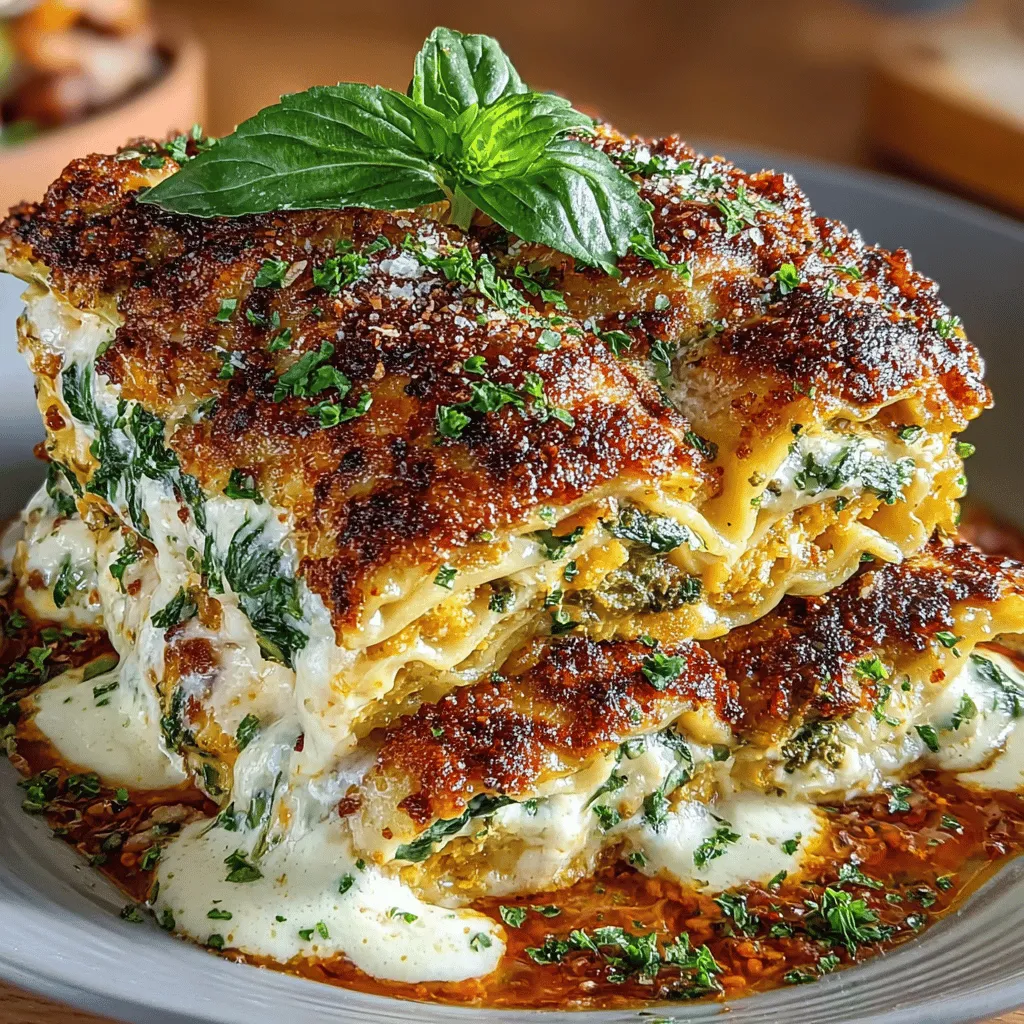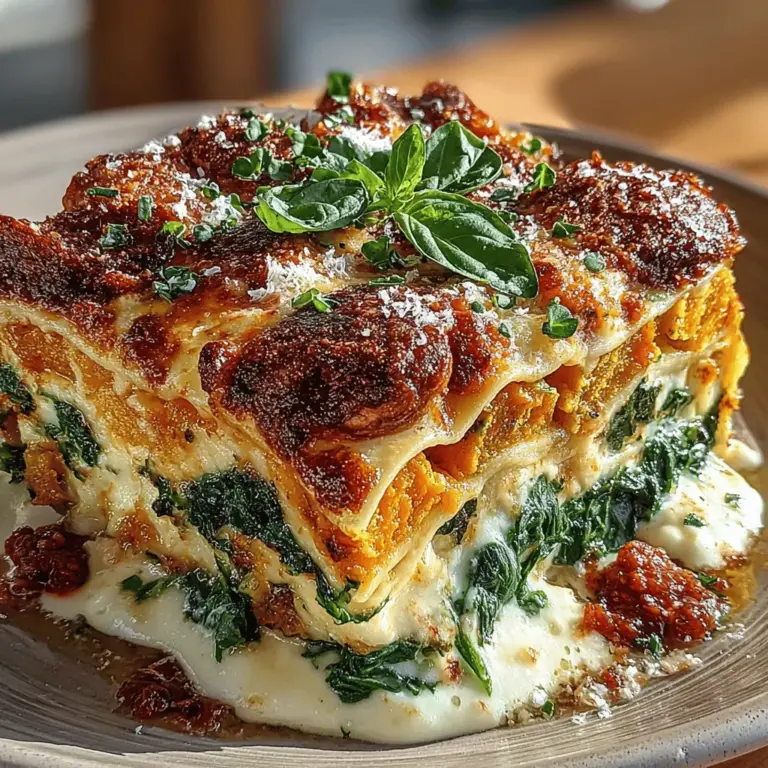Cozy Butternut Squash Spinach Lasagna: A Warm Embrace for Your Taste Buds
As the leaves begin to change and the air turns crisp, there’s nothing quite like the comforting embrace of a warm lasagna. This Cozy Butternut Squash Spinach Lasagna is designed to be a heartwarming dish that not only satisfies hunger but also nourishes the soul. With its rich layers of creamy cheese, savory marinara, and the delightful sweetness of roasted butternut squash, this recipe is perfect for autumn evenings or any time you crave a wholesome meal.
Lasagna has long been a beloved staple in many households, known for its versatility and the ability to bring family and friends together. This particular variation takes traditional lasagna to the next level, incorporating seasonal ingredients that are not only delicious but also packed with nutrients. The combination of butternut squash and spinach offers a unique twist on a classic dish, making it a fantastic option for vegetarians and anyone looking to incorporate more vegetables into their diet.
Key Ingredients: Butternut Squash and Spinach
At the heart of this lasagna are two star ingredients: butternut squash and spinach. Butternut squash, with its sweet, nutty flavor and creamy texture, serves as a wonderful base for the layers of cheese and noodles. Not only is it delicious, but it is also loaded with vitamins and minerals. Rich in beta-carotene, vitamin A, and dietary fiber, butternut squash supports eye health and digestion while providing a satisfying sweetness that balances out the savory elements of the dish.
Spinach, on the other hand, is a nutrient powerhouse. This leafy green is low in calories yet high in vitamins A, C, and K, along with iron and calcium. Its mild flavor allows it to blend seamlessly into the lasagna, adding a pop of color and a wealth of health benefits. The versatility of spinach goes beyond this recipe; it can be incorporated into countless dishes, from salads to smoothies, making it an essential ingredient in any kitchen.
To create a truly comforting lasagna, the choice of cheese is just as important as the vegetables. In this recipe, we will use a combination of ricotta, mozzarella, and Parmesan cheese. Ricotta adds a creamy texture and a mild flavor, while mozzarella provides that gooey, melty goodness that everyone loves. Parmesan brings a nutty, salty finish to the dish, enhancing the overall flavor profile. Lastly, marinara sauce ties everything together, adding acidity and richness that elevates each layer of the lasagna.
Preparation Process
Before diving into the layering of flavors, it’s essential to prepare your ingredients properly. Start by preheating your oven to 375°F (190°C). This step is crucial for achieving the perfect bake, as a preheated oven ensures that the lasagna cooks evenly and develops a beautiful golden crust on top.
Roasting the Butternut Squash
To begin, you’ll want to roast the butternut squash. This technique intensifies its natural sweetness and creates a creamy texture that integrates beautifully into the lasagna. Start by cutting the squash in half lengthwise, scooping out the seeds, and then cutting it into cubes. Toss the cubes with olive oil, salt, and pepper, and spread them out on a baking sheet. Roasting at 400°F (200°C) for about 25-30 minutes will caramelize the edges and bring out the best flavors. For added depth, consider sprinkling in herbs like thyme or sage before roasting.
Cooking the Lasagna Noodles
While the butternut squash is roasting, it’s time to prepare the lasagna noodles. If you’re using traditional lasagna noodles, bring a large pot of salted water to a boil. Cook the noodles according to the package instructions until al dente, then drain and lay them flat on a clean kitchen towel to prevent sticking. If you opt for no-boil noodles, you can skip this step, but be sure to have enough sauce to ensure they cook properly in the oven.
Creating Layers of Flavor
As the butternut squash roasts and the noodles cook, you can focus on sautéing the spinach. In a large skillet, heat a drizzle of olive oil over medium heat. Add the spinach and sauté until wilted, which should take just a few minutes. This quick cooking method helps preserve the nutrients and enhances the flavor, ensuring that the spinach maintains its vibrant green color.
Once the spinach has wilted, remove it from the heat and allow it to cool slightly before incorporating it into the cheese mixture. Combining sautéed spinach with ricotta, a pinch of salt, and some grated Parmesan creates a rich filling that perfectly complements the sweet butternut squash.
Now that you have prepared the key components of your lasagna, it’s time to construct the layers that will deliver a burst of flavor in every bite. The next step will involve assembling these components into a beautifully layered dish that showcases the delicious interplay of flavors and textures. As you build your lasagna, remember that each layer contributes to the overall harmony of the dish, setting the stage for a comforting meal that is sure to delight everyone at the table.

The Role of Egg in Binding the Ingredients
In our Cozy Butternut Squash Spinach Lasagna, the egg plays a crucial role in binding the layers together, ensuring a cohesive structure that doesn’t fall apart when served. The proteins in the egg coagulate during baking, providing the necessary firmness that holds the rich filling intact. This binding element is particularly important when using vegetables that have high moisture content, such as butternut squash and spinach. Without the egg, you may find the lasagna too watery and difficult to slice.
Balancing Flavors and Textures for Optimal Taste
Achieving a perfect balance of flavors and textures is key to an exceptional lasagna experience. The creamy ricotta and egg mixture combines beautifully with the roasted sweetness of butternut squash and the earthiness of spinach. Adding herbs like basil and oregano enhances the overall flavor profile, while layers of mozzarella provide that gooey, comforting texture we all crave in a lasagna. This medley of ingredients not only contributes to taste but also creates an inviting visual appeal that makes your lasagna a feast for the eyes.
Assembling the Lasagna
Layering Techniques
When it comes to assembling your lasagna, the layering technique is crucial. Start with a thin layer of marinara sauce at the bottom of your baking dish to prevent the lasagna from sticking. Then, alternate layers of noodles, filling, and sauce, ensuring each layer complements the last.
Step-by-Step Guidance for Creating Perfect Layers
1. First Layer: Spread a thin layer of marinara sauce on the bottom of your baking dish.
2. Noodle Layer: Place a layer of lasagna noodles on top of the sauce. Use enough noodles to cover the area while ensuring they don’t overlap too much.
3. Filling Layer: Next, add a scoop of the butternut squash and spinach mixture. Spread it evenly across the noodles.
4. Sauce Layer: Drizzle some marinara sauce over the filling, then sprinkle a layer of shredded mozzarella cheese.
5. Repeat: Continue this process, layering noodles, filling, sauce, and cheese until you reach the top of your dish. Make sure to reserve some cheese for the final top layer.
6. Final Layer: For the top, finish with noodles, a generous amount of marinara sauce, and a thick layer of mozzarella cheese to ensure a golden, bubbly finish.
Importance of Even Distribution of Ingredients
Ensuring even distribution of ingredients in each layer is paramount. This not only affects the cooking time but also ensures every bite is packed with flavor. Uneven layers can lead to some sections being overly dry while others are too wet. Take the time to spread each layer evenly and use a spatula to smooth out the filling for a uniform finish.
Visual Appeal and Flavor Balance
Layering your lasagna with care enhances not only the flavor but also its visual appeal. The contrasting colors of the orange butternut squash, deep green spinach, and creamy white ricotta create a vibrant dish that’s as pleasing to the eye as it is to the palate. The presentation matters, especially when serving guests, as an inviting dish sets the tone for a delightful dining experience.
How Layering Influences the Overall Taste Experience
The way you layer the lasagna influences the overall taste experience. By alternating flavors and textures, you create a complex dish where each bite offers a little bit of everything: creamy, cheesy, sweet, and savory. This careful layering helps to marry the flavors together, making every forkful an explosion of comfort.
Baking to Perfection
Covering and Uncovering the Lasagna
When it comes to baking your lasagna, start by covering it with aluminum foil. This helps to trap steam, allowing the noodles to cook thoroughly without drying out. After the first 30-40 minutes of baking, uncover the lasagna to let the cheese on top brown and become bubbly.
Techniques to Avoid Sticking and Ensure Even Cooking
To prevent the lasagna from sticking to the pan, be sure to grease your baking dish well before layering. You can use cooking spray or a light coating of oil. Additionally, ensure your oven is preheated to the correct temperature before placing the lasagna inside, which helps in achieving even cooking throughout.
Recognizing When the Lasagna is Done
To know when your lasagna is done, look for a few visual cues. The cheese on top should be golden and bubbly, while the edges may start to brown slightly. Additionally, you can insert a knife in the center; if it comes out hot and the filling is bubbling, you can be confident that it’s ready.
Importance of Resting Time Before Serving
Once your lasagna is finished baking, let it rest for at least 15-20 minutes before serving. This resting time allows the layers to set, making it easier to cut and serve. If you skip this step, you may find the lasagna a bit too loose, leading to a messy serving experience.
Serving Suggestions
Presentation Ideas for the Lasagna
When it comes to serving your Cozy Butternut Squash Spinach Lasagna, presentation is key. Slice the lasagna into squares and serve on individual plates. Consider placing a dollop of marinara sauce on the side and garnishing with fresh basil leaves for a pop of color and added flavor.
How Garnishing with Fresh Basil Elevates the Dish
Fresh basil not only enhances the visual appeal of your lasagna but also adds a burst of freshness that complements the rich flavors. Simply sprinkle some finely chopped basil on top just before serving for an aromatic touch that will elevate the dish.
Suggested Sides and Pairings
This lasagna pairs beautifully with a simple green salad dressed with a light vinaigrette. You might also consider serving it alongside garlic bread or a side of roasted vegetables to round out the meal. The freshness of a salad balances the richness of the lasagna, creating a well-rounded dining experience.
Ideal Accompaniments to Complement the Lasagna
For a more substantial meal, a glass of red wine, such as Chianti or a light Pinot Noir, can beautifully complement the flavors of the lasagna. If you’re serving this dish during a holiday gathering, consider including a cheese platter as a starter, featuring a variety of cheeses that will harmonize well with the comforting lasagna.
Health Benefits of the Recipe
Nutritional Analysis of the Dish
This Cozy Butternut Squash Spinach Lasagna is not just a treat for your taste buds; it also offers numerous health benefits. With a rich combination of vegetables, whole grains (if using whole wheat noodles), and dairy, it serves as a balanced meal option.
Caloric Content and Health Benefits Per Serving
Each serving of this lasagna is approximately 350-400 calories, depending on the specific ingredients used. Packed with vitamins A and C from the butternut squash and spinach, this dish is a great source of antioxidants, which help combat oxidative stress in the body.
Comparison to Traditional Meat Lasagna
Compared to traditional meat lasagna, this vegetarian version tends to be lower in saturated fat and calories, making it a healthier option for those looking to reduce meat consumption. The fiber content from the vegetables and whole grain noodles also promotes digestive health.
Discussing Dietary Considerations
This lasagna is a vegetarian-friendly dish, making it suitable for those who follow a plant-based diet. Moreover, it can easily be adapted for gluten-free diets by using gluten-free lasagna noodles, allowing more people to enjoy this cozy meal.
Conclusion
In summary, the Cozy Butternut Squash Spinach Lasagna is a delightful dish that combines comforting flavors with numerous health benefits, making it a wonderful choice for family meals or gatherings. Not only is it satisfying and wholesome, but it also allows for flexibility with seasonal ingredients, ensuring you can enjoy it throughout the year. We encourage you to try this recipe, share it with loved ones, and embrace the versatility of lasagna in your cooking repertoire. Whether you are a seasoned cook or a kitchen novice, this dish promises to be a hit at your dining table.


